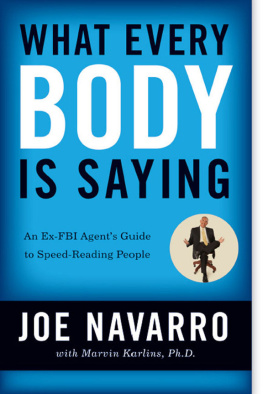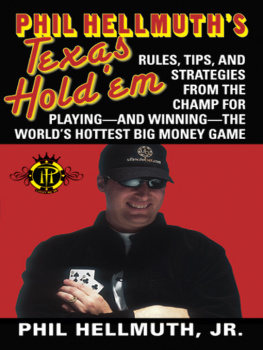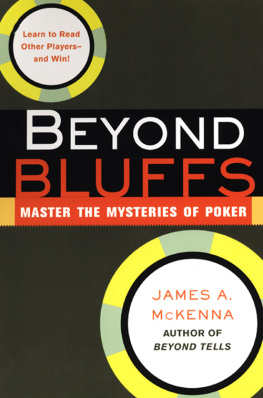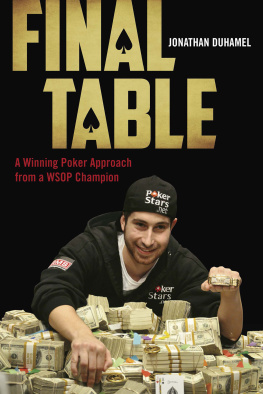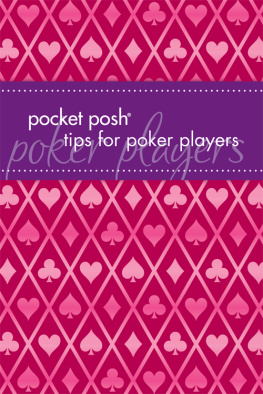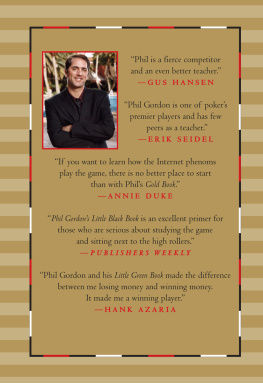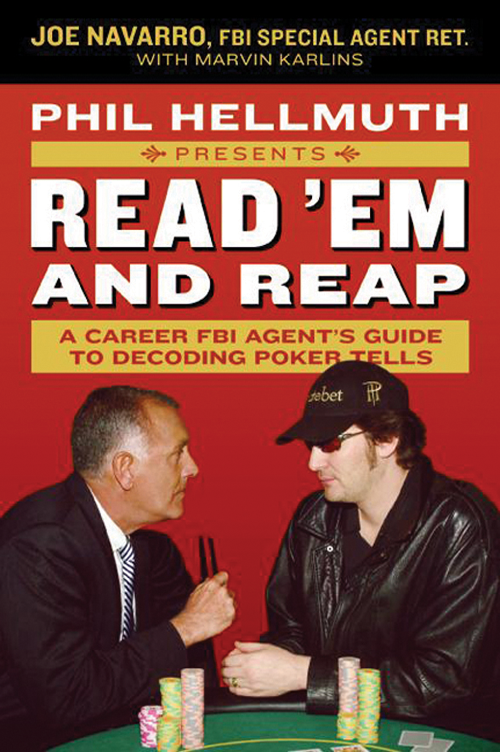Joe Navarro with Marvin Karlins, Ph.D.
One of the joys in writing a book is meeting and working with very talented and dedicated individuals. Our heartfelt appreciation goes to Matthew Benjamin, our editor at HarperCollins, who gave us unwavering support and valuable advice during all phases of this project. We are grateful to senior production editor Amy Vreeland and copy editor Jim Gullickson for catching our writing errors and making the text eminently more readable. Special recognition is also merited by the two gentlemen who put this whole project together: Jeff Goldenberg and Brandon Rosen at Post Oak Productions. We would also like to acknowledge the contributions of Jim Lewis (Phils manager), Brian Balsbaugh, (Phils agent), Andrew Feldman (ESPN Poker Club), and professional poker champions John Bonetti, T. J. Cloutier, Annie Duke, and Antonio Esfandiari. The cover photograph was provided by Joe Coomber, while the pictures inside the book were taken by Sonny Sensor (www.sonnyphoto.com). Paul Lord and his team at the Caesars Palace Poker Room in Las Vegas were very helpful, as were the staff from the Seminole Hard Rock Hotel & Casino in Tampa: John Fontana, president; Russ Christianson, Casino vice president; Mary Lynn Babetski, advertising manager; Gary Bitner, public relations representative; and the poker room staff. We would also like to recognize the individuals who appeared in the various pictures throughout the book: Soudara Noi Phrathep (casino dealer) and players Don Delitz, Amber Karlins, Robert Mercado, and Richard Ollis. To each of you, please accept our gratitude for all your efforts in our behalf. We couldnt have completed this project without you!
Personal thanks go out to my family and to my friends, especially Dr. Juan Ling, M.D., for his friendship over the years, which directly contributed to my involvement in this project. My gratitude also goes out to Dr. David Givens, Ph.D., Marc Reeser, Elizabeth Barron, and Dr. Joyce Jackiewicz, Psy.D., for their valued insight.
Finally, I want to thank the man who gave life to my words, Dr. Marvin Karlins. He has blessed me with his friendship, which turned hard work into pleasure.
Ten-time World Champion of Poker
When I sit down at a poker table, I play a game within the game: I try to guess exactly what two cards my opponent has in the hole. I can usually narrow it down to a very few possibilities, and on occasion I have ventured a guess out loud when I felt confident about it. Boy, did I freak the other players out when I would guess my main opponents Q-Q and he would then flip his Q-Q faceup and say, How in the world does he do that?
How in the world do I do it? Primarily through reading people, observing and deciphering their tells, the nonverbal behaviors that reveal the strength of the cards theyre holding. It is amazing how many poker players, even some world-class professionals, are unaware that theyre offering tells that render their hands transparent. These individuals might just as well turn their cards faceup and give their money away.
I clearly remember noticing a key tell by my well-known opponent in one World Series of Poker (WSOP) tournament that I wound up winning in 1997. Every time this opponent was going to fold his hand, he would put his chips halfway into the pot before it was his turn to act. So whenever I was in a pot with him and he was contemplating my move, he would push his chips halfway into the pot if he was weak. In one hand, the flop was A-9-8, and I checked with my 7-5. He bet out $14,000, and I began to think about what I wanted to do. With $65,000 left in chips, it was an obvious fold situation with my belly buster (inside straight draw). But suddenly, he pushed his chips halfway into the pot, and I knew I should move all-in! I pushed, he folded, and I went on to win my fifth WSOP bracelet.
In another tournament, at the 2001 WSOP, with two tables remaining, I noticed that whenever the player sitting to my right raised, he would lean back in his chair when he was weak. Conversely, he would lean forward when he was strong. Every time he leaned forward, I folded. Every time he leaned back, I pounced (I reraised and he folded). This allowed me to more than double up my chips with absolutely nothing in my hand, risk free. Just one tell on one opponent had allowed me to double my stack!
It is experiences like these, over the years, that have led me to formulate Hellmuths Tournament Poker 70-30 Rule: success in the game is 70 percent reading people and only 30 percent reading the cards (understanding the mathematical and technical aspects of the game). Tells do make all the difference!
Which brings me to Joe Navarro, a man who uses tells so successfully that he has earned the nickname the Human Lie Detector. Joe first came to my attention when fellow professional Annie Duke mentioned his name. She had been on a television program with him and was impressed with his ability to read people and determine if they were being deceptive or telling the truth. About a year later, the folks behind Camp Hellmuth, my poker fantasy camp (which has now merged with the WSOP Academy), told me they had hired Joe to give a seminar on tells for the camp participants. Little did I know at the time that he would receive better marks and higher praise from the campers for his session than for any other session offered, including mine! In fact, T. J. Cloutier and I both took three pages of notes during Joes one-hour presentation, which clearly demonstrated the importance we attached to what we were hearing. Later, we both expressed our amazement that we had taken any notes at all, much less three pages worth, since neither of us had ever taken notes at any previous poker seminars.
I was so impressed with Joe that I invited him to be part of the iAmplify.com project, where he provides 5-to-20-minute blasts in MP3 and MP4 formats for iPods and cell phones about nonverbal tells. Joe, you see, has been studying and using these nonverbal behaviors to detect deception and solve cases involving criminals and international terrorists during a distinguished 25-year career as a special agent with the FBI. His information is steeped in cutting-edge science, the kind that can help poker players and the U.S. government detect and decipher what their opponents are up to.
Joe also does individual consulting with top poker players throughout the world. In these one-on-one sessions, he will let players know what tells they project, but he will not reveal these tells to their competitors. I was one of the beneficiaries of this consulting opportunity. It turns out that Joe had watched me play in a no-limit Holdem tournament on television and noted that I had a glaring tell. Every time I bluffed, I would wrap my arms around my body in a kind of reassuring hug. The bad news was that the other players at the table picked up on my nonverbal tell and took me to the cleaners. That little gesture ended up costing me a quarter of a million dollars. The good news is that Joe informed me of the tell, and my hugging days are now over!
In this book, Joe presents you with priceless scientific information on tells, the kind that can make the difference between winning and losing at the poker table. This information has never been presented before, except at the Camp Hellmuth seminars. It takes poker to a new level and gives players a choice: they can either open the book and read it or become an open book that others can read .


